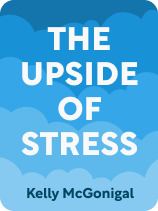

This article is an excerpt from the Shortform book guide to "The Upside of Stress" by Kelly McGonigal. Shortform has the world's best summaries and analyses of books you should be reading.
Like this article? Sign up for a free trial here.
How do psychologists define stress? What are the three types of stress response?
According to psychologist Kelly McGonigal, stress is your response when something valuable to you is at risk. Depending on the stress trigger and your perception of it, McGonigal defines three types of stress response: the fight-or-flight (threat) response, the challenge response, or the tend-and-befriend response.
Below, we’ll examine each one.
1. Fight-or-Flight (Threat) Response
The first type of stress response is the fight-or-flight response. This response occurs when you perceive your life to be in danger. For example, you’re felling a large tree in your yard and when you step back to watch the trunk tip away from you, you notice it’s starting to lean in your direction. Your body surges with energy and you leap clear of the crashing branches.
When your life’s on the line, fight-or-flight equips you for survival in a variety of ways:
- Your body releases hormones like adrenaline, cortisol, and dopamine to create and distribute more energy, motivate action, and increase your focus on an immediate threat.
- Your body releases excess stores of sugar and fat into the bloodstream for energy.
- You breathe harder and your heart starts racing to deliver oxygen, sugar, and fat more efficiently to your muscles.
- You slow or disable processes like digestion and growth that aren’t necessary for surviving an immediate threat.
- Your blood vessels constrict and inflammation increases in anticipation of injuries that will need repair.
- The fight-or-flight type of stress response makes you more aware of and reactive to similar triggers in the future.
In all these ways, fight-or-flight gives you energy and motivation, and it helps you repair injuries to survive immediate threats at a moment’s notice. However, this response has negative effects, too: As you process your environment in terms of its potential threat to you, you typically experience negative emotions like fear, shame, and anger.
Chronic fight-or-flight responses, in which your body frequently reacts with intensity to perceived threats, can cause long-term health effects like faster aging, suppressed immunity, and greater susceptibility to illnesses like cardiovascular disease.
2. Challenge Response
McGonigal explains that the challenge response to stress kicks in when you feel determined to achieve something or feel called upon to perform, but you don’t perceive your life to be at risk. For example, you’re heading into class to take a final exam, and you notice you’re breathing harder and your heart starts pounding. You feel confident in your preparation and determined to get an A. The challenge response prepares you for success in several ways.
A challenge response energizes you for action without harming your health, McGonigal says. Like the fight-or-flight response, a challenge response ramps up your breathing and heart rate to help you perform. However, because you don’t perceive a threat, your body doesn’t brace for injury by increasing inflammation and constricting your blood vessels—and McGonigal claims that these symptoms cause the harmful health effects associated with chronic fight-or-flight mode. Instead, your blood vessels remain relaxed, inflammation throughout your body does not increase, and you actually gain more energy than you do in a fight-or-flight response because your muscles receive more energy from increased blood flow.
(Shortform note: McGonigal points out that a challenge response to stress removes the harmful physiological effects of stress while retaining and even enhancing certain benefits, like increased energy production. However, one expert notes that the positive effects of a challenge stress response may lead to harmful behaviors. For example, the dopamine produced during stress feels good and creates motivation, which can cause challenge stress to become addictive. Thus, addiction to challenge stress’s feel-good effects could lead to over-exercising or workaholism, which can interfere with your daily life and relationships.)
A challenge response also enables you to recover and learn from stress more effectively. This is because, during a challenge response, you produce a higher ratio of the hormones DHEA to cortisol in your blood. DHEA increases the brain’s capacity to learn from stressful experiences. It also enhances immune function and injury repair. Cortisol helps you create and use energy efficiently during stressful situations by turning sugar and fat into fuel and pulling energy away from processes like digestion and growth. A higher ratio of DHEA to cortisol aids your recovery from a stress response by improving your heart and brain health. When the opposite happens and cortisol levels rise (which is typical in a threat response), it can result in immune system dysfunction, depression, and anxiety.
(Shortform note: Because a high DHEA is known to benefit your body and mind, it’s important to maintain a healthy DHEA/cortisol ratio. Research suggests that your DHEA levels peak between ages 20 and 30, and then decline slowly with age. However, one study shows that you can naturally increase your DHEA level throughout your lifetime with regular exercise, especially resistance training.)
In a challenge response, your body releases other hormones like adrenaline and dopamine to increase energy, motivation, and focus. However, because you don’t perceive a threat, you feel confident rather than afraid. McGonigal claims that increased confidence, along with elevated energy, allows you to perform better during exams, competitions, and at work.
A challenge response even enables you to perform better than if you have no stress response. One study observed the difference between a challenge response and a threat response using the Trier Social Stress Test—a stress-inducing simulation that requires participants to give a spontaneous presentation and take a surprise math test in front of unsupportive judges. Participants with a challenge response had more confidence, performed better, and had a healthier post-test mental state than participants who exhibited threat responses or low-stress responses.
3. Tend-and-Befriend Response
This stress response occurs when you perceive that a person or community you care about needs help. For example, you’re concerned for the mental health of a friend as they process a break-up, so you drive an hour through the night to comfort them in person. Likewise, this response can be triggered by your own need for support. This instinct for connection is driven by the following physical reactions:
Release of Oxytocin
A tend-and-befriend response triggers the release of the social hormone, oxytocin, which makes you more courageous, empathetic, and trusting of others.
(Shortform note: Connecting with other people isn’t the only way to boost oxytocin and reap its benefits. Research shows that petting your dog can increase oxytocin significantly in both you and your dog.)
One study found that participants who watched their loved ones experience pain from electric zaps felt less afraid and more empathetic if they held their loved one’s hand during the test.
(Shortform note: The study McGonigal refers to shows that connecting with a loved one while they experience pain can dampen your fear, but how does physical connection with a loved one affect the person feeling the pain? A similar study measured the effects of holding hands on the recipient of electric shocks, showing that this physical connection also reduced the feeling of pain caused by the test.)
Oxytocin also nullifies the negative health effects caused by extreme, traumatic events or chronic fight-or-flight. One study found that oxytocin released during a stress response protected rats from heart damage during chemically induced heart attacks. The heart attacks only occurred when the rats were given a drug that inhibited oxytocin.
Release of Serotonin
Another dominant hormone in the tend-and-befriend stress response is serotonin, which makes you more aware of your surroundings. In this way, you’re better able to notice critical details and act more effectively. For example, you’re stressed because the baby you’re caring for is crying. Because your tend-and-befriend response is triggered and your awareness is heightened by serotonin, you notice the baby is wriggling uncomfortably in your arms and her belly is bloated. These symptoms tell you she’s likely crying because she has to burp.(Shortform note: If serotonin benefits cognition, how can you increase your serotonin levels? Research shows that you can increase serotonin with daily exposure to bright light (preferably, sunlight) and performing regular, aerobic exercise.)

———End of Preview———
Like what you just read? Read the rest of the world's best book summary and analysis of Kelly McGonigal's "The Upside of Stress" at Shortform.
Here's what you'll find in our full The Upside of Stress summary:
- Why stress is an ally that should be embraced
- How stress can lead to enhanced health, greater success, and a more meaningful life
- How to change your mindset about stress to receive its benefits






